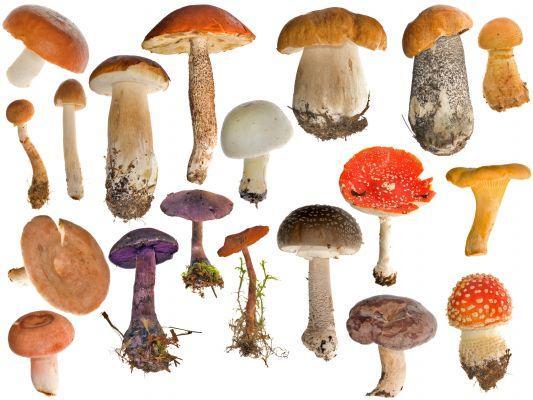
I mushrooms, erroneously considered by many to be vegetables, they belong to a kingdom in their own right, that of the protists. Unlike plants, it doesn't they have neither roots nor leaves and are devoid of chlorophyll (green substance that allows plants to "feed themselves", through the process known as photosynthesis).
Il nutritional value of mushrooms is comparable to that of vegetables, for labundant amount of water present (80 - 90%), even if they contain a most relevant protein fraction (3 - 5%).
Discreet is the content of vitamins B1 and B2; low in vitamin C. I minerals present (0,5 - 1,5%) are potassium, phosphorus, copper, iron and calcium. The sugar they are less than 3 - 5% and lipids are almost absent. They are also present cellulose e chitina (< 3 %), fibre alimentari non digeribili. Tra i composti minori vi possono essere l'u (consisting of nitrogen), pigments (responsible for the color of certain fungi), antibiotic substances, toxins and alkaloids, with poisonous or hallucinogenic properties.
Among the approximately 100 known species of edible mushrooms, the best known in the country are the porcini: easily recognizable by the brown cap without gills and the cream-colored stem, they grow from May to November. It is a fleshy mushroom, with a firm and white pulp, the smell is insignificant but the taste is excellent.
Le morels they have a characteristic conical spongy cap, sometimes roundish, and cylindrical or swollen, smooth or wrinkled stem, but always hollow and white in color; they are found from March to June.
Le russole, from the globose and smooth cap, to slimy voilte, and from the hollow and white stem with whitish gills, they are characterized for a notable chromatic variability: from red to brown, up to cream white, however always in bright colors; their season runs from May to September.
I chanterelles they have roughly the shape of a funnel, with a smooth, shiny cap and a beautiful yellow / orange color; the lower surface of the cap, bright yellow in color, is crossed by current folds along the entire length of the stem which is short, yellow, full and fibrous. The smell is very pleasant and the flavor is accentuated; they can be harvested from June to November.
Some species of fungi lend themselves to cultivation in special air-conditioned greenhouses, in which the spores of the fungi are "seeded" in cultivation beds filled with sterile soil and covered with peat, lime and water.
I cultivated mushrooms are available all year round and the most common species in the country are the champignonthe champignon, and the pioppino or piopparello, with a cream-colored hat and beige or tobacco strips.
Mushrooms are an excellent opportunity in a low-calorie dietary context, as they give a remarkable flavor to preparations with very few calories.
How to choose mushrooms
- Fresh and clean mushrooms, whole and with the cap attached to the stem, firm, uniform in color and without spots, with a pleasant and delicate smell.
- The label of the packaged mushrooms must mention the place of origin, that of the dried mushrooms must bear the expiry date.
- Porcini mushrooms must have a firm stem and a yellow or green underside of the cap, never dark; size is not a quality criterion.
- Avoid limp, wrinkled, or dark mushrooms with bruised gills or the cap separated from the stem.
Mushrooms in the kitchen
Before using them in any preparation, wild or cultivated mushrooms must always be carefully cleaned: cut the hard and earthy part at the base of the stem, brush them with a soft brush specific for mushrooms and finally rub them gently with a damp sponge. Dried mushrooms must be soaked in warm water for 20 minutes, then squeezed.
All cultivated mushrooms can be eaten raw or stewed as well they are used in many preparations. Excellent sautéed, in risotto, fried in batter or stewed, they can also be eaten raw in salads. Mushrooms in oil or vinegar lend themselves to being tasty appetizers. Wild mushrooms can be kept in the refrigerator for a maximum of 1-2 days; those cultivated also resist 4-5 days.
Good to know
It is important to pay close attention to the collection of wild mushrooms: if you are not an expert, it is better to buy them in the store. It is necessary to dispel the classic clichés that assert that the silver immersed in the cooking water of poisonous mushrooms blackens; poisonous mushrooms do not always have an unpleasant smell or taste; not all mushrooms that change color when cut are poisonous and vice versa (for example, the phalloid amanita, very poisonous, does not change color), boil or wash i mushrooms with water and vinegar does not at all eliminate the toxicity of poisonous ones.


























